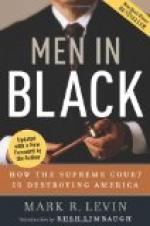The growth of the court cafes was made possible by the amelioration in the climate of New England effected through the alteration in the course of the Gulf Stream. The inhabitants became accustomed to spend more time in the open air so that the courts became popular. Existing as places for the display of eccentricities and the airing of personal grievances, they soon became extremely frequented as places of amusement.
Whenever any litigant felt that there was any matter in dispute which needed adjustment by some outside agency, he invited the other party to come to the court. The judges occupied the position of proprietors, maitres d’hotel, and waiters, whose business it was to make the courts as attractive as possible. As their salaries depended upon the amount of receipts and the courts were run upon a partnership basis in which all shared the profits, the aim of the judges was to draw as large amount of custom as possible.
The surroundings were in every way desirable. In the open air, under spreading trees with the sunlight filtering through the leaves upon the well-kept lawns, were spread tables covered with delicious fruits and every delicacy that the human mind could devise in the way of culinary delights. Rare wines, exotic flowers were constantly supplied in profuse display. Luxurious divans and reposeful seats were interspersed about. The most modern as well as the most famous musicians furnished exquisite music, while flitting about in neat white aprons partially concealed by their gently swishing gowns of black, the attentive justices anxiously tried to add to the pleasure and comfort of their customers.
With such temptations as these there was little wonder that the opposing party accepted the invitation to attend court. Witnesses and spectators crowded about, both on account of the novelty of the institution and the opportunity for refreshment and amusement. The aim of the judges was to incite the disputants to continue their disputes instead of trying to pacify them.
The more vociferous they grew, the more noisy and passionate they became, the better the crowds were held who came to observe the performance. It was upon this clientele and the sale to them of viands and comestibles during the dispute that the profits of the judges depended. So long as there was a serious and energetic struggle the spectators remained at the adjacent tables and trade was brisk. Whenever, however, the litigants came to a full realization of the absurdity of their position, either by the continued laughter of the spectators at the public airing of their private wrongs with which the public had nothing to do, or becoming tired of mere words and came to diminish the ardor of their combat, the crowd would begin to dwindle away. The judges quick to understand the loss of trade after vainly trying to induce the litigants to new efforts, would gently and suggestively push under their hands a pair of dice boxes or a pack of cards and the dispute would sometimes end upon the throw of a die or the turn of a card.




